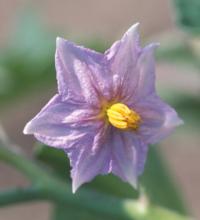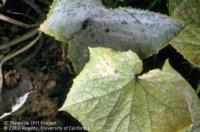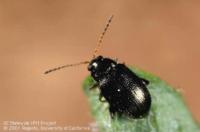Eggplant, problems
-
Flower Drop
If the flowers on your eggplants form but then fall off, or if fruit does not develop, the most likely problem is that the temperatures are too cold.
Eggplant requires warm temperatures for blossom set and fruit development. The ideal daytime temperatures should be in the range 80° to 90° F and night time temperatures should not go below 60° to 65° F. Eggplant does not tolerate frost, and growth will be significantly slowed if night temperatures are below 60° F.
Solution - wait for warmer temperatures; you may have to replant, depending on the variety.
Read more about when to plant eggplant.
Powdery Mildew
If there are white, powdery spots on the leaves of your eggplants, your plant may have powdery mildew. Powdery mildew is a common disease which affects a wide variety of vegetable crops including eggplant, peppers and tomatoes, all in the nightshade family. Powdery mildews generally do not require moist conditions to establish and grow, and normally do well under warm conditions; thus they are more prevalent than many other leaf-infecting diseases during the summer.
Powdery mildew first appears as white, powdery spots that may form on both surfaces of leaves and on shoots. These spots gradually spread over a large area of the leaves and stems. Leaves infected with powdery mildew may distort or gradually turn completely yellow, die, and fall off, which may expose fruit to sunburn. Powdery mildew fungal growth does not usually grow on vegetable fruits.
The best method of control is prevention. Planting resistant varieties when available, planting in full sun, and following good cultural practices will adequately control powdery mildew in many cases.
Read more about management of powdery mildew.Flea Beetles
If your eggplant leaves have small holes, and you see small jumping insects, the plant may have flea beetles. Flea beetles are small, jumping beetles with enlarged back legs.
Adults feed mostly on leaves, leaving tiny pits or small holes. Flea beetles feeding together can cover leaves with bleached, pitted areas or ragged holes. Damage is usually serious only on young seedlings. Beetle larvae feed on roots and stems.
Remove garden debris in the fall to remove any overwintering beetles. Protect young seedlings with protective coverings; older plants are less likely to suffer damage. Aluminum foil mulch applied very soon after planting and before plants become infected can be helpful. White sticky traps can be used to monitor or trap adults. Insecticides should not normally be necessary and are not very effective when populations are high.
Read more about management of flea beetles.



